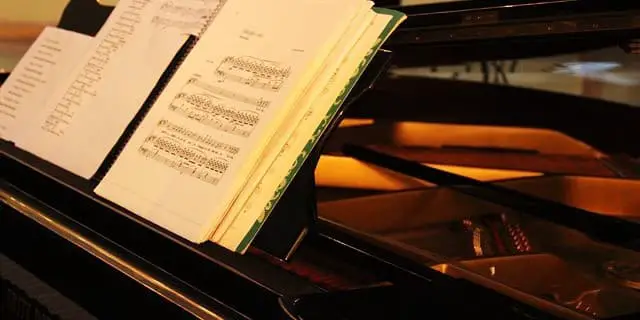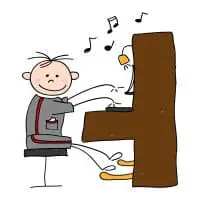- Home
- Piano Practice
- How to Memorize
How to Memorize a Piano Repertoire as an Adult Beginner
This article may contain compensated links. Please read the disclosure for more info.
Learning how to memorize a few piano pieces to keep "in your pocket"; even as a beginner, always ready to perform, takes a bit of planning and preparation.
Here are 5 steps on preparing and a simple formula for memorizing a repertoire of easy piano pieces ready for performing!
How to Memorize a Piano Repertoire as a Beginner
One of the joys of playing an instrument is being able to share the music. But unless you are already skilled at improvising and playing piano by ear, here are some great tips on how to memorize and keep a short repertoire of pieces to share with your friends at any time!
Typically, learning and memorizing a repertoire looks like this
- Choose pieces you enjoy: Start by selecting pieces you genuinely love and feel confident playing. This will make the memorization process easier and more enjoyable.
- Break down the piece into smaller sections: Instead of trying to memorize the entire piece at once, break it down into smaller sections. Start by memorizing the first few measures, then move on to the next section, and so on.
- Practice regularly: Make a schedule to practice the pieces every day. The more you practice, the easier it will be to remember the pieces.
- Play with a metronome: Playing with a metronome will help you develop a consistent tempo and make it easier to memorize the rhythm.
- Record yourself: Recording yourself playing the pieces can help you identify any mistakes or areas that need improvement. It can also help you better understand the piece as a whole.
- Play for others: Finally, share your pieces with others. The more you perform, the more confident you will become and the easier it will be to remember the pieces.
Following these tips, you can memorize and share a short repertoire of pieces in no time! But let's go deeper. Here are 5 steps on how to memorize a repertoire for piano:
5 Steps for a Memorized Piano Repertoire
Here is a step-by-step plan for preparing and memorizing a piano repertoire!

1. Select Your Repertoire
Start by selecting 4 to 5 pieces that are easier than you usually choose to play. See if you can find piano pieces in different styles to make your repertoire more varied.
For a great selection of easier piano pieces, perfect for social events, look at this collection of piano songs.
2. Learn the pieces with notes
Fun Tip! Use visual aids: Create flashcards with the notes and chords of each piece. You can also draw a simple chart of the piece to help you remember the structure.

Yes. Obviously, first, learn the pieces with notes.
Then, Begin With The End In Mind:
Make sure to learn the beginning and end of a piece first.
Why? Well, that is where the attention is most focused in a performance.
You can goof up in the middle of the piece quite a lot, but if you finish elegantly, all is forgiven!
Likewise, the beginning of a piece is like the first impression of someone, so do make sure it is neat and tidy!
3. Simplify
If the piece has some small tricky technical bits, simplify them. Remove anything unnecessary, as long as it doesn’t ruin the music, of course.
Remember that no one (except you) is interested in you having conquered something difficult (most people wouldn’t notice anyway). Instead, most people prefer and love listening to a beautifully performed piece without apparent mistakes.
3. About Repeats...
Typically, attention is short at social gatherings (unless you play a song everyone wants to sing along with!).
You don't have to play all variations of Scott Joplin's The Entertainer, for example, or all parts of Beethoven's Fur Elise.
You do not have to play all the repeats, either. For example, Billy Joels The Piano Man has many repeats and verses. This piece is meant to be sung along with it. So if nobody sings, you don't need to play all the repeats!
On the other hand, some people love the plinkety-plink of the piano as a background sound while talking. In this case, is it great with repeat after repeat, so you can keep playing for a long time…!
4. Now Memorize each piece with a simple formula!
When learning how to memorize an easier piano piece, you can use a simple formula:
- First, learn the piano piece with notes.
- Then play 2-4 measures twice without mistakes while staring at the notes.
- Play the same part twice more still with the notes in front of you, but this time look at your hands and the piano keys instead. You may "cheat" by looking up, but keep your eyes mainly on your hands and the keys.
- Play twice more with a closed book (no "cheating") and keep looking at the keyboard and your hands.
- Continue in the same way with the following 2-4 measures.
- After learning the whole piece like this, combine larger parts of 4-8 measures, and then even larger.
- Keep adding parts together until you can play the whole piece by heart.
Tip: Here is a tool for more help to learn how to memorize music: How to Memorize Music - A Practical Approach for non-Geniuses.
5. Maintenance
Just because you have learned how to memorize a piece doesn’t mean it stays that way…
To keep your hard work fresh and ready to be played, your piano songs will need some regular maintenance:
- The first week after memorizing a piece, play it preferably several times a day or a minimum of once daily.
- The second week, play every other day.
- The third week, three times.
- The fourth week two times. Then play your piano piece/s at least once every week for as long as you want to keep that piece in your repertoire.
As you learn new pieces, you can trade old piano pieces with new ones or keep them forever on your repertoire, whatever you prefer.
But remember to keep polishing your little repertoire, and grab every opportunity to share it with others!





